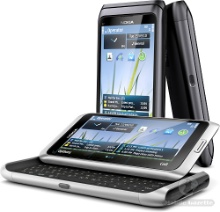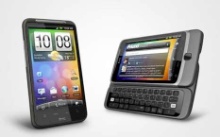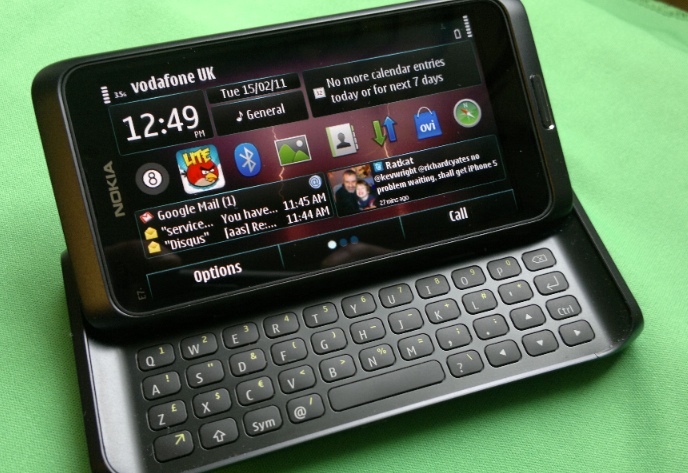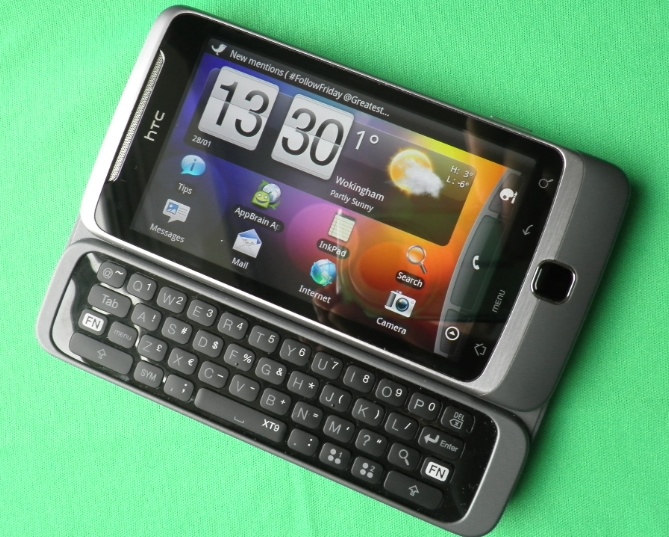The HTC Desire Z, in particular, seems to have attracted a number of ex-Nokia, ex-Symbian fans, making it an even more appropriate comparison:
As with previous head to heads, where appropriate/possible (in some rows it's simply too subjective or there isn't a clear leader), I've shaded in a 'winner' in green for each attribute, to give a visual guide to possible superiority.
| Nokia E7 | HTC Desire Z | |
 |
 |
|
| Form factor and input method, build quality | Aluminium shell with pivoting Gorilla glass display on metal hinge. Lovely hardware, lovely form factor, incredible build quality, amazingly thin for the keyboard size | Part metal, part plastic QWERTY monoblock with pivoting screen top section that folds flush with keyboard |
| Display | 4" CBD AMOLED, pretty good in sunlight, 640 pixels by 360, all screens work in both portrait and landscape modes | 3.7" Super LCD, not good in sunlight, average indoors, 800 pixels by 480, all screens work in both portrait and landscape modes |
| Keyboard | Four row keyboard, nominal key travel but excellent feel, punctuation via long key presses or Fn/Sym keys | Four row keyboard, acceptable key travel and feel, poor key legend visibility (grey on dark grey), confusing punctuation extension system |
| Weight | 176g | 180g |
| Operating system and interface | Symbian^3, firmware updates just beginning, expecting two or three minor updates and one major update in 2011. | Android 2.2, will get updated to v2.3 at some point - HTC rarely seem to hurry, even slower than Nokia. |
| Free RAM, free user memory, expansion for apps and media | Over 140MB free RAM, over 330MB free on system disk, 16GB mass memory, no expansion. The absence of microSD expansion not only limits capacity, it also takes away a means of transferring media between devices. Partly to compensate for this, a USB on the go system (via supplied adapter) means that USB sticks/disks can be connected. Not exactly elegant though. | Up to 300MB free RAM, over 1GB of free system disk flash memory, plus microSD expansion. |
| Processor, chipset notes, peformance | ARM11, 680 MHz, plus Broadcom BCM2727 graphics acceleration, pretty quick for most (though not all) operations | 800MHz Scorpion processor plus graphics acceleration (pretty quick overall) |
| Use one-handed if needed | Possible but limited, due to screen size | Possible, but some restrictions due to screen size |
| Camera | 8 megapixels EDoF (i.e. full focus, no macro), dual LED flash. Disappointing not to have auto-focus. | 5 megapixels auto-focus, LED flash, but usual HTC component (lack of) quality. |
| Camcorder | Excellent 720p video with digital sound | Acceptable 720p video and quietish audio capture |
| Application load-out highlights (out of the box) | Ovi Maps with free navigation, Ovi Store, Quickoffice editing suite, Photo and Video editors | HTC Sense additions to Android, Google Maps 5 and Navigation, HD YouTube client, Android Market, Google Gmail |
| Web browsing/working on the Internet | Web as per the N97 and E90, with Flash built-in and now with multitouch support. Interface is dated and multi-stage page rendering now clumsy with 2011 Megabyte+ web pages. Still waiting for the promised next-gen Nokia browser. | Android Browser, fairly speedy and modern, with Flash built-in. |
| Messaging, Email | Nokia Email (nee Messaging) works pretty well, albeit a little slow. Many people find bypassing Nokia's servers (by declining the terms of service) improves things a lot, using IMAP directly, but your mileage may vary. | Basic generic email client, but truly excellent Gmail experience. |
| Audio out | 3.5mm, plus tinny mono speaker | 3.5mm, plus very tinny, small mono speaker |
| Battery capacity, life | 1200mAh, fixed with no user access at all, recharge each night, microUSB charging | 1300mAh replaceable, recharge each night, microUSB charging |
| Connectivity notes | Quad-band GSM, Pentaband 3G, Bluetooth, Wi-Fi, GPS | Quad-band GSM, dual band 3G, Bluetooth, Wi-fi, GPS |
| Video apps and capabilities | Symbian^3 video player, handles H.263/H.264/AVC MP4, plus DivX, WMV and many other formats and variants. HDMI out to compatible equipment | Adequate video playback for most MP4 variants, DLNA media sharing |
| Application ecosystem | Plentiful software, including HD GPU-aware games, weak area is cloud service integration apps | Plentiful software, very strong on cloud service integration and niche utilities, though relatively weak on commercial grade games |

Looking at the green panels will give us a quick overview here, as always: the Nokia E7 just takes the crown, by 8 'greens' to 6. As usual, I've considered the full range of converged functions that a smartphone should be able to perform, which is as usual to the Symbian phone's advantage. However, advocates of the 'smart means online services' definition of 'smartphone' will point to some of the software boxes above, in which the Android-powered phone currently has the advantage.
I'd suggest that when the PR 2.0 software arrives for the E7 (now pegged at late April?), with the new browser, pixel-draggable homescreens and split-screen text entry, and by which time even more of the current generation of Qt utilities and apps will have been released, the E7 will edge further into the lead, but there's also the balancing (negative) factor now of knowing that Symbian itself is on a downward curve in terms of OS investment, while Android is still being furiously developed.
It's fair to say that I wasn't hugely enamoured of the HTC Desire Z's hardware when I did my Phones Show review of it. Will HTC ever get it right in terms of hardware? Will they ever invest in decent cameras, speakers, microphones and hinges? Until then, Nokia's sumptuous design and build quality is noticeably superior, in almost all commentators' eyes.
Your comments on this revised head to head are most welcome!
Steve Litchfield, All About Symbian, 23 Feb 2011 Updated, 23 March 2011

